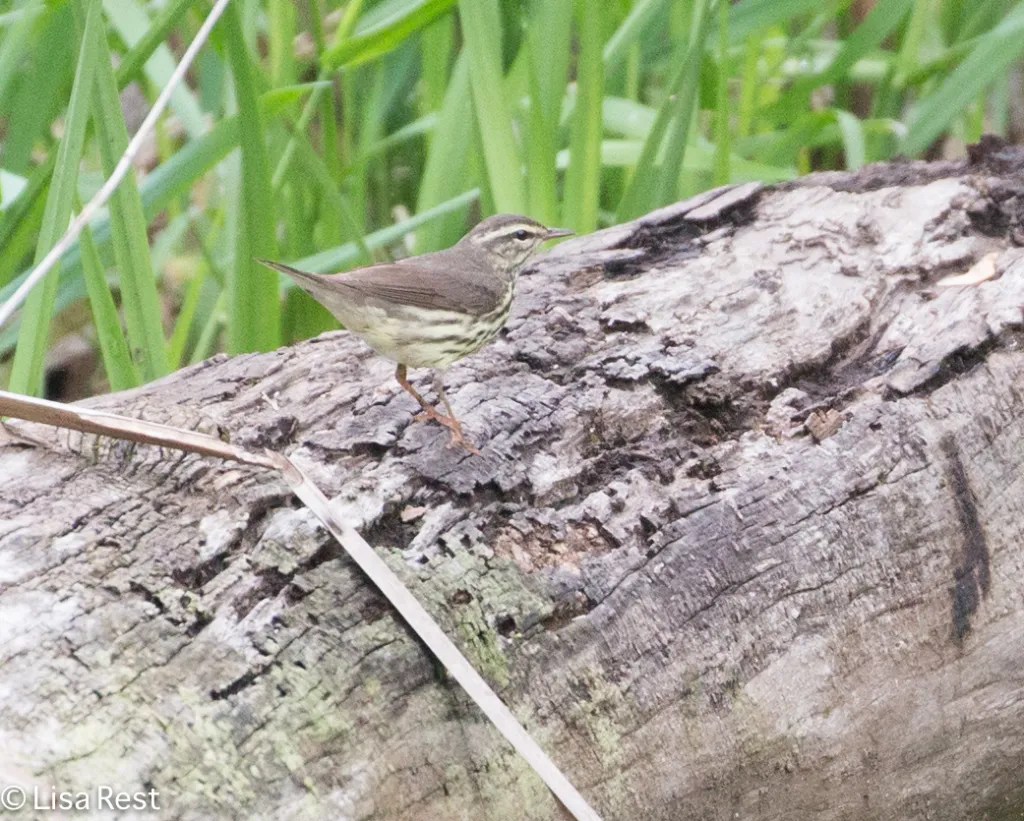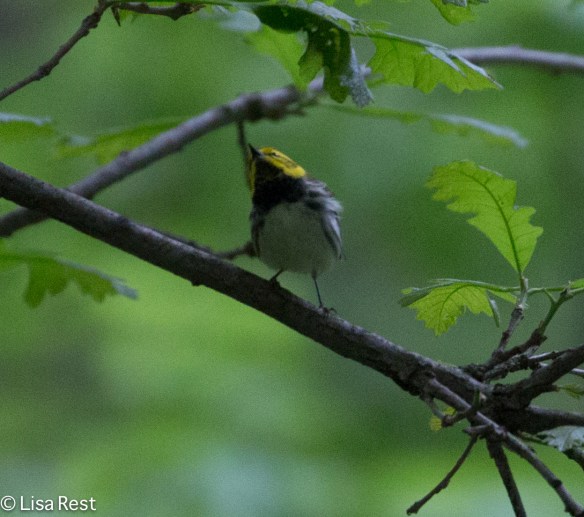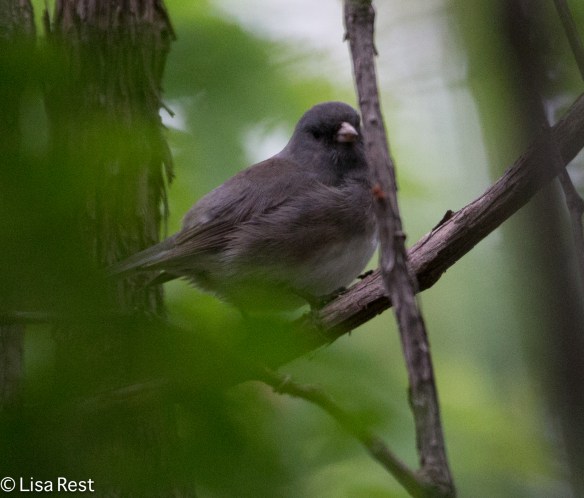
Last Saturday morning, I led the first of two Unity Temple Auction bird walks at the Chicago Portage. After the group left, I stayed and found more birds with Bob Smith. I went back again the next day. Both days were cloudy and sometimes even a little drizzly, which did not make for great photographs, but I took too many photos anyway. Spring migration is finally rolling.
Before I go further, I just wanted to share the photograph below that reminds me of a wallpaper pattern. Birds have a natural artistic sense.

WARNING: This post has too many photographs. You may get dizzy. I certainly did trying to get them all in here. For the sake of expediency I am forsaking any attempt at order. Sort of.
American Redstarts are always a challenge, even in good light.




Below is a first-year male American Redstart.
And then a second year or older male…
There have been a lot of thrushes at the Portage. Below are Swainson’s Thrushes.




I have seen several Gray-cheeked Thrushes too. The unfortunate lack of light didn’t help with the images of the one below.


Northern Waterthrushes, several of which have been present lately, are a different type of New World Warbler. They’re not thrushes. I thought I heard somewhere that they now had their own classification, but they are still in the parulidae family.





Another Northern Waterthrush, down close to the water where they normally forage.





Yellow-rumped Warblers are still around.








Back to the Thrushes. Below are two individual Veerys seen on both days.






Scarlet Tanagers are back. A pair could stay to breed at the Chicago Portage.



Indigo Buntings are back to raise families as well.


My Indigo Bunting friend Tadziu was not available when I led the group through the trails, but he showed up later on Saturday. Below the photos is a video I took of him the Thursday before, which has some of his song.





If you remember my Flicker Mania post from April 15 when Northern Flickers were Everywhere, by contrast, it’s now definitely a challenge to catch a glimpse of one of them.

House Wrens fill the air with their chattery songs. Most are staying for the summer.

Tennessee Warblers can also make a lot of noise, but they have been difficult to spot.
A Baltimore Oriole is below, collecting material for her fabulously constructed nest.





This Black-throated Green Warbler almost disappeared into the green.





Blue-gray Gnatcatchers are not easy to spot these days. They’re way up high and maybe even a little harder to hear with their wheezy song.



They were much easier to see just a couple weeks ago.
Another bird that can be heard everywhere but makes a rare appearance – a Warbling Vireo.

I barely caught a glimpse of a female Common Yellowthroat (in the first two photos below) and then discovered I had by chance barely captured the male as well. This is a warbler of open fields and some park-like settings, and is most often found in shrubby habitat. They stay all summer and you might even forget about them were it not for often hearing the male singing his “witchety wichety” song loudly from some hidden location.
Below is an Eastern Wood-Pewee, a flycatcher that normally stays through the summertime at the Portage. It has a lyrical song for a flycatcher that can often be heard from quite far away. If I hear one singing closer, I will have to see if I can record him.

On Sunday I saw the Great-crested Flycatcher below. Ebird tells me I saw my first one this year on May 9.

Empidonax flycatchers are often tricky to identify, especially without accompanying vocalizations. I believe the bird below is a Least Flycatcher, which is also the Least Difficult to ascertain.
Another Swainson’s Thrush is below. I finally heard one singing yesterday.




It was hard to capture a Nashville Warbler those two days.




I have since seen more Magnolia Warblers and I promise to post some better pictures soon.



We still had a Dark-eyed Junco last weekend, which came up rare for such a late date.



Chestnut-sided Warblers have been around for a week or more. I promise better photos to come of this bird too.







Below is one of two Osprey that flew over late Saturday morning.

The Wilson’s Warbler below was kind enough to offer his most reliable field mark, although in better light, I can wax rhapsodic over Wilson’s Warbler Yellow.

Northern Cardinals might be a little puzzled – or bored – by all the fuss over the influx of other brightly-colored birds. They seem less bothered by the camera’s attention lately.

We saw a Beaver swimming in the stream Saturday morning. We also saw a Muskrat later but I didn’t get a respectable photo.

Swallows were busy. There were Northern Rough-winged Swallows… which I saw, incidentally, this morning before it started to rain.
And there were Barn Swallows.
White-crowned Sparrows were easier to see.



I saw my first Blackpoll Warbler last weekend.






I promise not to do this again…it’s too hard to organize. But I just had to let loose with these photos before diving into the rest of them. Spring Migration is like the Holy Grail.
I was praying for rain this morning but the forecast was indecisive, so I went to the Portage. It started to rain in earnest about twenty minutes after I got there, so I switched priorities and did my grocery shopping. I will go back out to swim shortly. My new plants are grateful for the rain. And since I didn’t manage to stay up late last night to finish this post, so am I.
Tomorrow is the second auction bird walk and the forecast couldn’t be better. We should have plenty of sunshine which will make it easier to see the birds.























Wow you have been firing away with the camera and getting great pictures. Back from Magee having seen a number of warblers as well as a woodcock and a Virginia rail. Great trip, it is such fun taking to all those birders as one walks the crowded Magee Marsh Boardwalk. I got a few good pictures. I also need to check closer for the gray-cheeked thrush.
Hi Bob! Welcome back! I can only imagine all you saw at Magee. It’s been a long time since I’ve seen a Woodcock or a Virginia Rail.
Gray-cheeked are tricky. I always sort of get a feel for the look on the face being kind of wan. I did finally see a Wood Thrush yesterday in Riverside. There have been so many thrushes this season I think they almost outnumber the warblers.
Such variety, Lisa! So many birds! I wish my eyesight was better and I could really see. You’re right that birds are artistic and I think your lead photo, itself, is a piece of art.
Thank you so much, Babse! I treasure your compliment coming from the artist in you. The birds create their own expressions and I am blessed by their tolerance for my presence.
The fact that you can see all these birds, take pictures of them, and know what they all are makes my head spin. You are a wonder.
Dear Tom, thank you so much. It’s a form of meditation, in the slowness, the discipline of concentrating on motion or a vocalization or, when I’m lucky, both. A lot of it is luck, really, just being in the right place at the right time. I always encounter someone who has seen something fabulous that I missed. 🙂